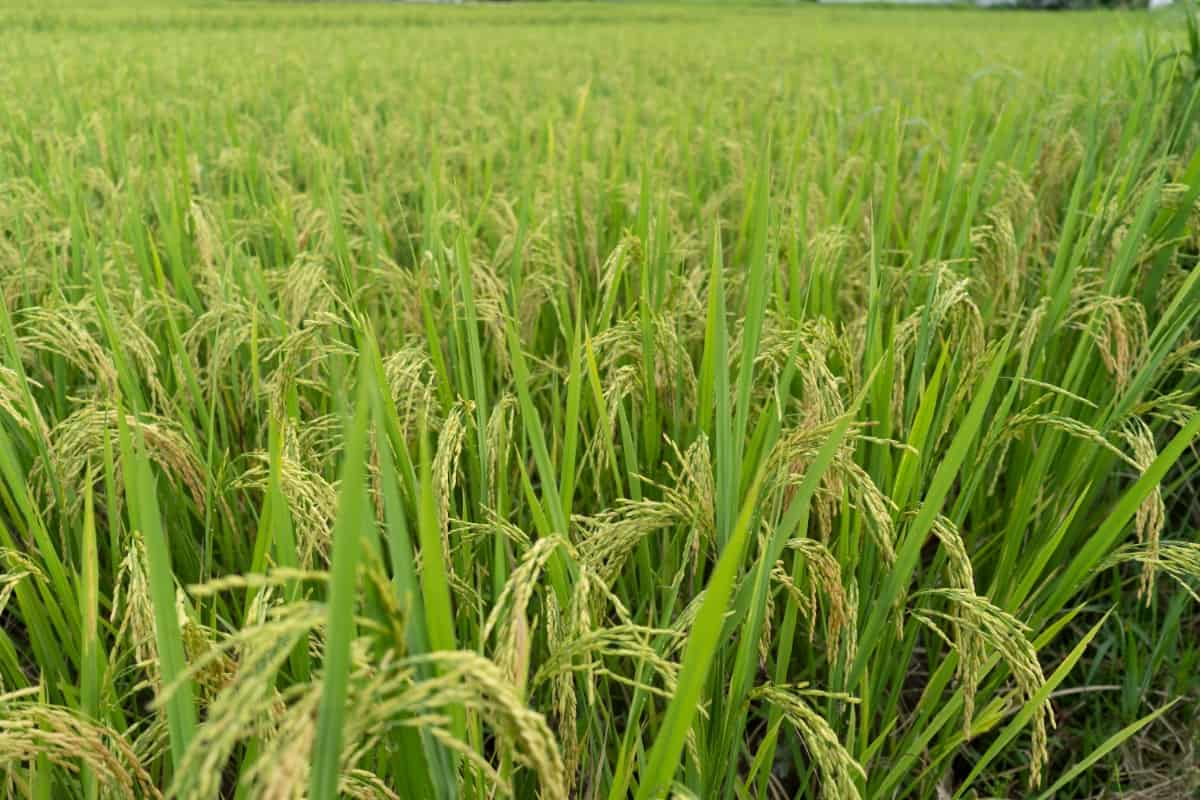Welcome to our comprehensive guide on the best and latest pesticides available for rice/paddy crops. As an expert in the field, I’m here to equip you with valuable insights on effectively controlling insect pests and diseases, ensuring a bountiful harvest, and maximizing profits. You can use cutting-edge pesticides to safeguard your crop against the relentless threats that jeopardize its health and yield. Get ready to empower your farming endeavors with the knowledge you need for a prosperous rice crop!

Best and Latest Pesticides for Rice/Paddy
What are Pesticides?
Pesticides are chemical substances that control, mitigate, or eliminate pests that can damage crops and plants or harm human health. They play a crucial role in modern agriculture by effectively managing insect pests, fungi, and weeds.
- Insecticides: These pesticides are specifically formulated to target and control insects. They disrupt the pests’ nervous, respiratory, or reproductive systems. Insecticides prevent insect damage and the transmission of diseases, ensuring healthier and more productive crops.
- Fungicides: Fungi can cause devastating diseases in plants, reducing yield and quality. Fungicides are designed to inhibit fungal growth and prevent the spread of diseases. They protect plants by killing the fungi or inhibiting their development, helping maintain crop health.
- Herbicides: Weeds compete with crops for resources, such as water, nutrients, and sunlight. Herbicides are chemicals that selectively kill or inhibit the growth of weeds, allowing crops to flourish without competition. By effectively managing weeds, herbicides contribute to higher yields and reduce the need for manual weed control.
Benefits Of Pesticide Usage to Crop
- By effectively managing pests, pesticides enable farmers to produce abundant, nutritious fruits, vegetables, grains, milk, and proteins, essential for human health and childhood development.
- Pesticide usage contributes to increased availability and affordability of crops, as it helps maintain crop quantity and quality.
- Farmers can produce a diverse range of crops throughout the year, thanks to the protection provided by pesticides against pests and diseases.
- With lower costs associated with pest control, farmers can allocate their resources more efficiently, reducing production costs for food and animal feed.
- Pesticides contribute to a stable and sustainable food supply, meeting the demands of a growing population and ensuring food security.
Need of Latest Pesticides for Rice/Paddy Crop
Paddy crop, particularly rice, is a vital staple food in many Asian nations. With a crop duration of approximately 90 to 110 days, rice plants are susceptible to various pests, including insects, plant pathogens causing diseases, and weeds that hinder their growth. Various pesticides, including insecticides, fungicides, and herbicides, are utilized in paddy crop production to combat these threats.
This post aims to delve into the major pests affecting rice plants and provide an updated list of chemical pesticides designed to control them. We will also discuss these pesticides’ technical and trade names, along with recommended dosages for effective application. By understanding these latest pesticide options, farmers can safeguard their rice crops and optimize their yields while ensuring accurate and comprehensive pest control measures.
In case you missed it: 1 Acre Paddy/Rice Cultivation Project Report in India: Production Cost and Profit

List of Pesticides, Insecticides, and Fungicides to Control Major Pests and Diseases in Paddy Crop
- Thiamethoxam 25% WG: Targeting sucking pests like brown plant hoppers and white-backed plant hoppers, it is applied at 50-100 grams per acre as a seed treatment.
- Imidacloprid 17.8% SL: Effective against termites, stem borers, and leafhoppers, it is applied as a soil drench at a dosage of 250-500 milliliters per acre.
- Chlorpyrifos 20% EC: This insecticide controls pests such as stem borers, leaf folders, and leaf rollers. It is applied as a foliar spray at 1-1.5 liters per acre.
- Quinalphos 25% EC: Targeting pests like leaf folders, leafhoppers, and green leafhoppers, it is applied as a foliar spray at a dosage of 1.5-2 liters per acre.
- Carbendazim 50% WP: An effective fungicide against sheath blight and blast diseases, it is applied as a foliar spray at 200-300 grams per acre dosage.
- Propiconazole 25% EC: This fungicide controls blast disease and sheath blight. It is applied as a foliar spray at a dosage of 300-400 milliliters per acre.
- Tricyclazole 75% WP: Targeting blast disease, it is applied as a foliar spray at a dosage of 300-400 grams per acre.
- Hexaconazole 5% SC: Effective against sheath blight and blast diseases, it is applied as a foliar spray at a dosage of 250-500 milliliters per acre.
- Metalaxyl-M 4% + Mancozeb 64% WP: This fungicide controls blast and sheath blight diseases. It is applied as a foliar spray at a dosage of 500-750 grams per acre.
- Azoxystrobin 23% SC: Targeting sheath blight and blast diseases, it is applied as a foliar spray at a dosage of 200-300 milliliters per acre.
- Bacillus thuringiensis var. kurstaki 0.5% WP: This biopesticide controls pests like leaf folders and stem borers. It is applied as a foliar spray at a dosage of 500-750 grams per acre.
- Buprofezin 25% SC: Effective against brown plant hopper and white-backed plant hopper, it is applied as a foliar spray at a dosage of 300-400 milliliters per acre.
Note: Farmers should carefully follow the label instructions and consider local recommendations for accurate dosages and modes of application.
List of Herbicides to Control Major Weeds in Paddy Crop
- Pyrazosulfuron-Ethyl 70% WDG: This broad-spectrum herbicide controls major broadleaf weeds, sedges, and grassy weeds in paddy crops. It can be applied as a pre-and early post-emergence herbicide, inhibiting shoot growth and killing weeds.
- Pretilachlor 50% EC: Targets grassy weeds such as Echinochloa spp. and Leptochloa chinensis. It is applied as a pre-emergence herbicide at a dosage of 600-750 grams per acre.
- Butachlor 50% EC: Controls grassy weeds like Echinochloa spp. and Leptochloa chinensis. It is applied as a pre-emergence herbicide at a dosage of 1-1.25 liters per acre.
- Pendimethalin 30% EC: Targets a wide range of grassy and broadleaf weeds. It is applied as a pre-emergence herbicide at a dosage of 1-1.25 liters per acre.
- Bispyribac-sodium 10% SC: Controls broadleaf weeds such as Ludwigia spp., Eclipta spp., and Ammania baccifera. It is applied as a post-emergence herbicide at a dosage of 25-30 grams per acre.
- Pyrazosulfuron-ethyl 10% WP: Targets broadleaf weeds and sedges like Cyperus rotundus and Fimbristylis miliacea. It is applied as a post-emergence herbicide at a dosage of 15-20 grams per acre.
- 2,4-D sodium salt 80% WP: Controls broadleaf weeds like Monochoria vaginalis, Polygonum spp., and Ludwigia spp. It is applied as a post-emergence herbicide at a dosage of 500-750 grams per acre.
- Metsulfuron-methyl 20% WP: Targets broadleaf weeds including Scirpus spp., Alisma spp., and Monochoria spp. It is applied as a post-emergence herbicide at a dosage of 4-6 grams per acre.
In case you missed it: Benefits of Rice Water in Your Garden: Apply for Potted, Terrace, Indoors, and Backyard Plants

Conclusion
The best and latest pesticides for rice/paddy crops are crucial in controlling insect pests and diseases, ensuring safe and high-quality food production, and ultimately leading to better farmer profits. Proper pest management practices are essential for sustainable and profitable rice cultivation.
- Feed Your Flock for Less: Top 10 Tips to Save on Chicken Feed
- Ultimate Guide to Ossabaw Island Hog: Breeding, Raising, Diet, and Care
- Hatching Answers: The Top 10 Reasons Your Chickens Aren’t Laying Eggs
- Eggs and Economics: Breaking Down the Cost of Raising Backyard Chickens
- Defend Your Greens: Proven Methods to Keep Iguanas Out of Your Garden
- Ultimate Guide to Cinnamon Queen Chicken: A Comprehensive Guide for Beginners
- Ultimate Guide to California Tan Chicken: Breeding, Raising, Diet, Egg-Production and Care
- Ultimate Guide to Marsh Daisy Chicken: Breeding, Raising, Diet, and Care
- 10 Types of Chicken Farming Businesses You Can Start for Profits